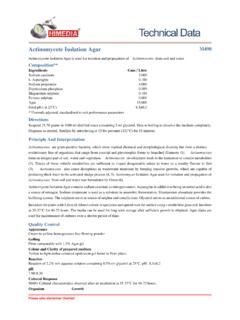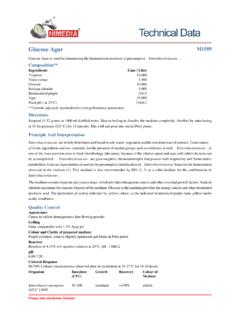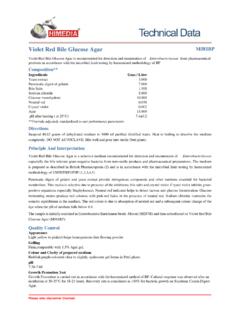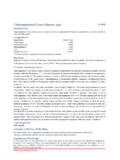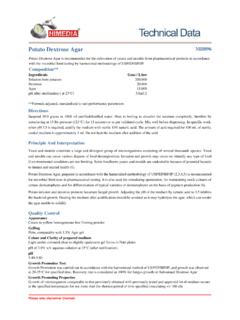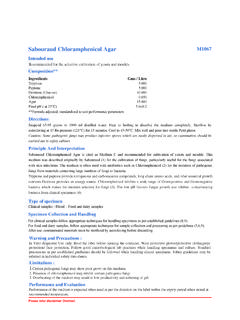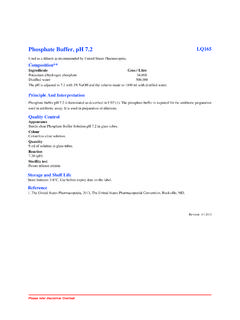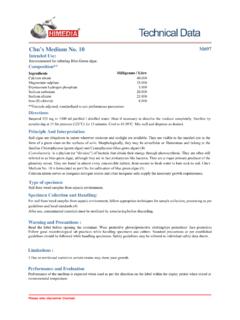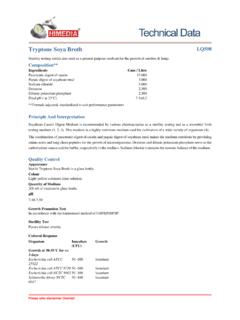Transcription of HiCrome Bacillus Agar - HiMedia Labs
1 HiCrome Bacillus AgarIntended useM1651 Recommended for isolation and differentiation between various species of Bacillus from a mixed culture in foods, clinical and non-clinical samples by chromogenic **IngredientsGms / extract # pH ( at 25 C) **Formula adjusted, standardized to suit performance parametersDirectionsSuspend grams in 1000 ml purified/distilled water. Heat to boiling to dissolve the medium completely. Sterilize by autoclaving at 15 lbs pressure (121 C) for 15 minutes. Cool to 50 C and aseptically add rehydrated contents of 1 vial of Bacillus Selective Supplement (FD324) if desired. Mix well and pour into sterile Petri And InterpretationMajority of Bacillus species apparently have little or no pathogenic potential and are rarely associated with disease in humans or lower animals.
2 The principal exception to this are Bacillus anthracis, the agent of anthrax, and Bacillus cereus , but a number of other species, particularly those of the group, have been implicated in food poisoning and other human and animal infections (7). Bacillus cereus causes food poisoning due to consumption of contaminated rice (2,5,10), other starchy foods such as potato, pasta and cheese have also been implicated, eye infections and a wide range of other clinical conditions like abscess formation, meningitis, septicemia and wound Bacillus agar is based on the formulation of MYP agar formulated by Mossel et al (6) used for enumeration of Bacillus cereus and Bacillus thuringiensis when present in large number in certain foodstuffsThe medium contains peptone and HM extract, which provide nitrogenous, carbonaceous compounds, long chain amino acids, vitamins and other essential growth nutrients.
3 Mannitol serves as the fermentable carbohydrate, fermentation of which can be detected by phenol red. Mannitol fermenting organisms like B. megaterium yield yellow coloured colonies. The chromogenic mixture present in the medium is cleaved by the enzyme beta-glucosidase found in resulting in the formation of blue colonies. also grows as blue/green colonies on this medium as and are biochemically identical, however shows flat colonies with distinct blue centers, while shows irregular margins. If selective isolation of or is required aseptically add Bacillus Selective supplement (FD324).#-Equivalent to Meat extractType of specimen Clinical samples - Blood , pus, eye exudates ; Food and dairy samples. For clinical samples follow appropriate techniques for handling specimens as per established guidelines (3,4).
4 For food and dairy samples, follow appropriate techniques for sample collection and processing as per guidelines (1,8,9). After use, contaminated materials must be sterilized by autoclaving before discarding. Specimen Collection and Handling: Please refer disclaimer LaboratoriesTechnical DataCultural ResponseCultural characteristics observed after an incubation at 30 C for 24-48 ResponseOrganismInoculum(CFU)Growth w/oaddition ofFD324 Recovery w/o addition ofFD324 Growth w/addition ofFD324 Recovery w/addition ofFD324 Colour ofColonyCultural ResponseBacillus subtilis subsp. spizizenii ATCC 6633 (00003*)50-100fair20-30%inhibited0%yello wishgreen to greencoloniesBacillus cereus ATCC 1087650-100good-luxuriant>=50%good-luxur iant>=50%lightblue,large,flatcolonies withblue centreBacillus thuringiensis ATCC1079250-100good-luxuriant>=50%good-l uxuriant>=50%lightblue,large,flatcolonie s withirregularmarginsBacillus megaterium ATCC1458150-100good-luxuriant>=50%inhibi ted0%yellow, mucoidcoloniesBacillus coagulans ATCC7050 (00002*)50-100good-luxuriant>=50%inhibit ed0%pink,small,raised coloniesBacillus pumilis ATCC1488450-100good-luxuriant>=50%poor10 -20%light green togreen coloniesStaphylococcus aureus subsp.
5 Aureus ATCC 25923 (00034*)50-100luxuriant>=50%inhibited0%y ellow coloniesEnterococcus faecalis ATCC29212 (00087*)50-100luxuriant>=50%inhibited0%l ight green togreen coloniesPlease refer disclaimer , comparable with agar gelColour and Clarity of prepared mediumRed coloured, clear to slightly opalescent gel forms in Petri platesReactionReaction of w/v aqueous solution at 25 C. pH : and Precautions :In Vitro diagnostic Use only. Read the label before opening the container. Wear protective gloves/protective clothing/eye protection/ face protection. Follow good microbiological lab practices while handling specimens and culture. Standard precautions as per established guidelines should be followed while handling clinical specimens. Safety guidelines may be referred in individual safety data to variable nutritional requirements, some strains may show poor growth on this colour variation may be observed depending upon the utilization of the substrate by the ControlAppearanceCream to yellow homogeneous free flowing powder expiry period when stored atPerformance and EvaluationPerformance of the medium is expected when used as per the direction on the label within therecommended temperature.
6 * - Corresponding WDCM numbersHiMedia LaboratoriesTechnical P. R., Baron J. H., Pfaller M. A., Jorgensen J. H. and Yolken R. H., (Eds.), 2003, Manual of Clinical Microbiology,8th Ed. American Society for Microbiology, Washington, D. A. A., Koopman M. J. and Jongerium E., 1967, Appl. Microbiol., 15 P. R. and McCann G., 1974, Lancet, E., Grant S., Jordan C. et al, 1979, Arch. Ophthamol., 97 K., Kirkbride C. A., Bicknell E. J. and Ellis R. P., 1972 Am. Vet. Met, Ass. 161 and Shelf LifeStore dehydrated medium in a tightly closed container and the prepared medium at 2-8 C. Use before expiry date on the label. On opening, product should be properly stored dry, after tightly capping the bottle inorder to prevent lump formation due to the hygroscopic nature of the product. Improper storage of the product may lead to lump formation.
7 Store in dry ventilated area protected from extremes of temperature and sources of ignition Seal the container tightly after use. Use before expiry date on the performance is best if used within stated expiry period. User must ensure safe disposal by autoclaving and/or incineration of used or unusable preparations of this product. Follow established laboratory procedures in disposing of infectious materials and material that comes into contact with clinical sample must be decontaminated and disposed of in accordance with current laboratory techniques (3,4). , Clinical Microbiology Procedures Handbook. 2nd , , Pfaller , , Carroll, , Funke, G., Landry, , Richter, and Warnock., (2015)Manual of Clinical Microbiology, 11th Edition. Vol. Y., and Tortorello Fifth (Ed.), 2001, Compendium of Methods for the Microbiological Examination ofFoods, 5th Ed.
8 , American Public Health Association, Washington, Public Health Association, Standard Methods for the Examination of Dairy Products, 1978, 14th Ed., H. M. and Frank J. H., 2004, Standard Methods for the Microbiological Examination of Dairy Products, 17th Ed.,APHA Inc., Washington, : 03 / 2017In vitro diagnostic medical device CE MarkingDo not use if package is damagedCE Partner 4U ,Esdoornlaan 13, 3951 DB Maarn The Netherlands, IVDS torage temperature2 C8 CEC REPHiMedia Laboratories Pvt. Limited, 23 Vadhani Industrial Estate, LBS Marg,Mumbai-86,MS,India Please refer disclaimer LaboratoriesTechnical DataDisclaimer :User must ensure suitability of the product(s) in their application prior to use. Products conform solely to the information contained inthis and other related HiMedia publications.
9 The information contained in this publication is based on our research and developmentwork and is to the best of our knowledge true and accurate. HiMedia Laboratories Pvt Ltd reserves the right to make changes tospecifications and information related to the products at any time. Products are not intended for human or animal or therapeutic use butfor laboratory,diagnostic, research or further manufacturing use only, unless otherwise specified. Statements contained herein should notbe considered as a warranty of any kind, expressed or implied, and no liability is accepted for infringement of any Laboratories Pvt. Ltd. : 23, Vadhani , LBS Marg, Mumbai-400086, India. Customer care No.: 022-6116 9797 Corporate office : A-516,Swastik Disha Business Park,Via Vadhani Ind. Est., LBS Marg, Mumbai-400086, India.
10 Customer care No.: 022-6147 1919 Email: Website.
